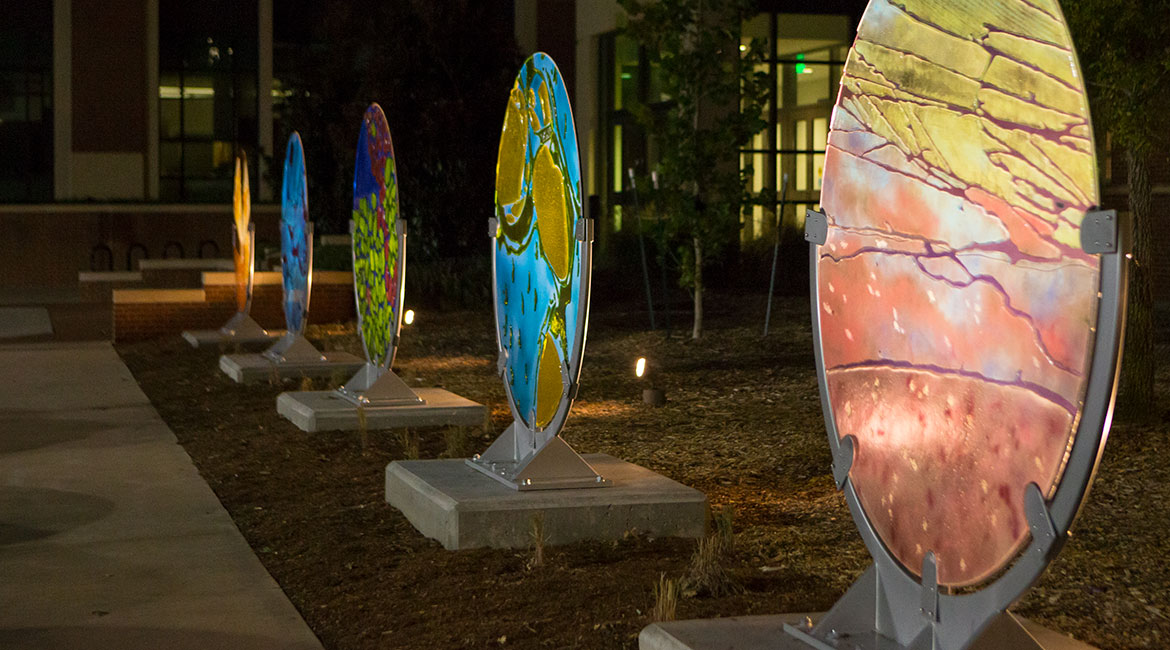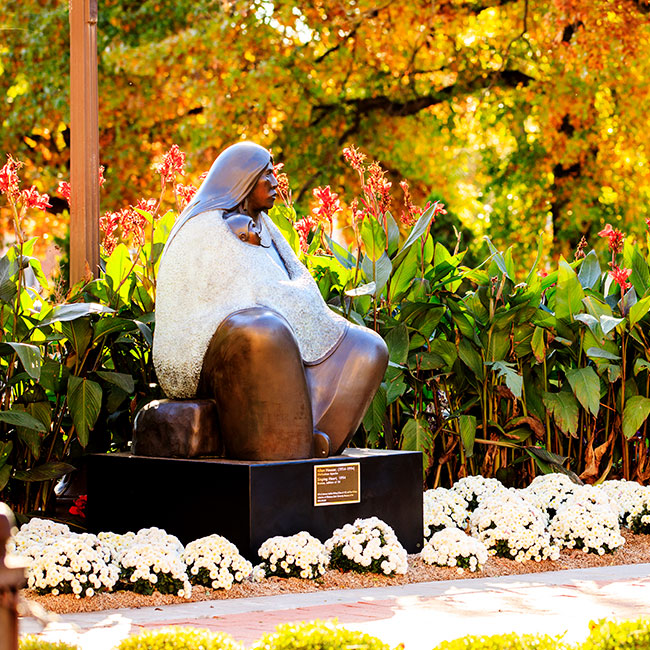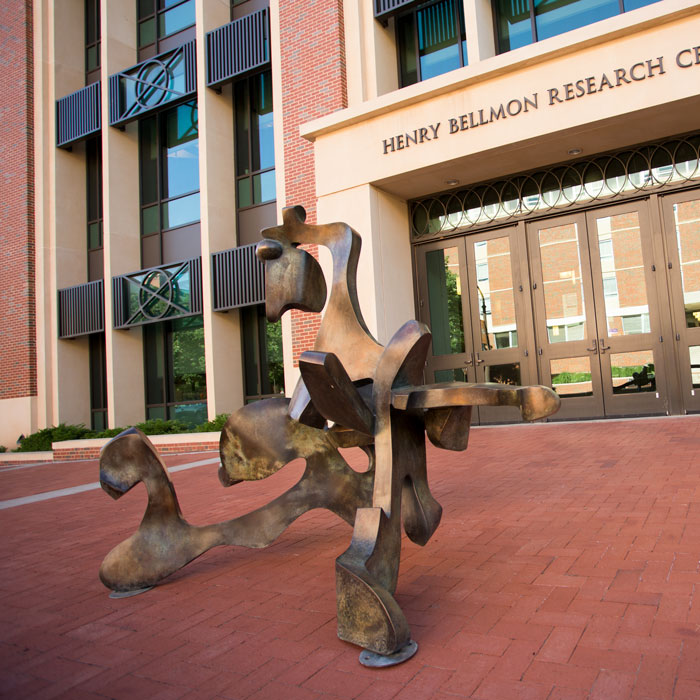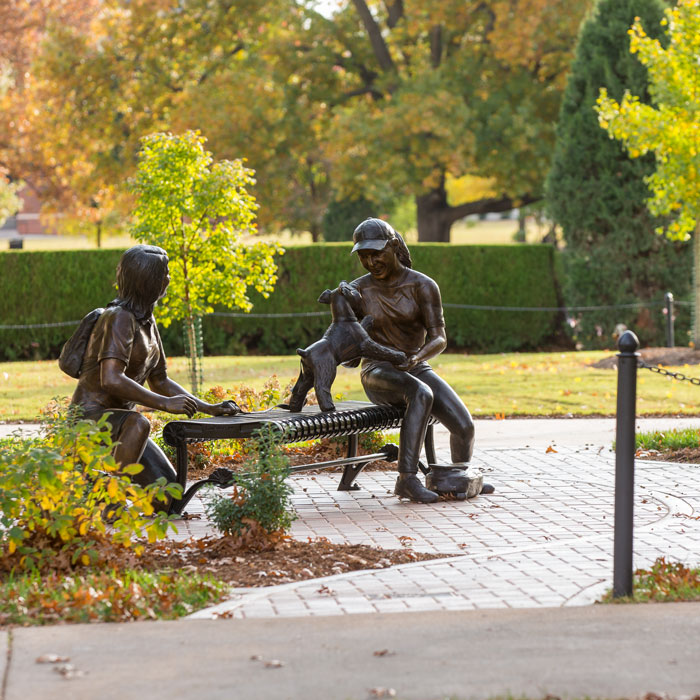
The Education of Art
Wednesday, May 1, 2019
Sculptures are opening eyes and minds on OSU’s campus
"I read once that art awakens the soul. It impacts people. It inspires people."
OSU alumnus James Pickel has taken these words to heart. The Oklahoma City businessman, a 1972 Oklahoma State University graduate, serves on the university’s Public Art Committee and donated Allan Houser’s Abstract Orange sculpture to his alma mater last fall.
Pickel’s enthusiasm for supporting the program is as intense as the sculpture’s orange.
“I believe it is important for the community to be exposed to the arts, and this work felt like the perfect thing for me to contribute,” he said. “Having the opportunity to preserve it in the official OSU orange was the icing on the cake.”
Under the leadership of OSU President Burns Hargis, cultural amenities have taken a major step forward at Oklahoma State. The OSU Museum of Art opened in the former Postal Plaza in downtown Stillwater in 2014, bringing the university’s art collection to the public. The McKnight Center for the Performing Arts, set to open in the fall, will attract national and international performances. Hargis has also made installing public art on the campus a focus — a visible tribute to the university’s commitment to the arts and their importance to education. The art initiative and commission of the Public Art Committee in 2015 made Abstract Orange and other works possible.
“It’s all part of the education process,” Hargis said. “As you see different genres, it’s a broadening of experience. Plus, it’s beautiful. Incorporating public art was a mission I wanted to start, and I think we are.”
Hargis said how a campus looks also provides a competitive advantage, and Oklahoma State is perfectly suited to display sculptures and other public art.
“These kinds of pieces enhance the overall appearance of the campus,” he said. “The great thing about OSU is the buildings are not stacked so tightly together that you can’t have any perspective. You can actually appreciate the buildings and the public art.”
Guiding the way
Abstract Orange is one of many public art displays on campus, taking art from the cool confines of a museum and making it accessible to everyone. The sculptures co-exist with the brick and mortar architectural landscape and integrate the experience of art into everyday life. Public art adds beauty, color, form and uniqueness to the campus. The works of public art function as alternative avenues for learning about history and memorializing human achievement. And they’re available to enjoy 24 hours a day.
Every step of adding an artwork to the campus is guided by the Public Art Committee as part of the beautification program. First Cowgirl Ann Hargis serves on it with Pickel; Victoria R. Berry, director of the OSU Museum of Art; Steve Dobbs, director of OSU Landscape Services; faculty; alumni; community members; and a representative from the Oklahoma Arts Council Art in Public Places Program.
Every project is different and requires not only those willing to donate to acquire the art, but expertise in selecting and installing it as well.
“Each of our campus art installations has its own unique story,” said Berry.
‘A fitting addition’

Singing Heart was the first Allan Houser sculpture installed. The mother and child sculpture is on view in the Mothers Garden on the west side of the Atherton Hotel. Its acquisition grew out of the interest of Jeanene Jenkins Hulsey (class of ’67) and husband Ron. Jenkins Hulsey is an active member of the OSU Museum of Art’s Advisory Board and the OSU Art Advisory Council. The couple have been committed patrons of the museum since its inception. They live in Santa Fe, New Mexico, where the Allan Houser Sculpture Garden is located.
“The OSU campus is widely regarded as America’s most beautiful campus, and it’s our hope that this sculpture contributes to that beauty,” Jenkins Hulsey said. “Our appreciation of Houser’s work coupled with his Oklahoma background and love for education made this sculpture seem like a fitting addition.”
Just south of the Student Union is the Welcome Plaza, an award-winning installation that serves as the gateway for OSU, greeting alumni, visitors and potential students and their families. Commissioned in 2015, famed Texas artist Marrita Black created a mare and her colt, the embodiment of a mother allowing her child to leave her side and blaze a trail into a new life. Named Proud and Immortal, the horses are one of the most photographed areas on campus.
The public art initiative gained greater visibility with the first outdoor year-long exhibition on campus in 2017: Action Abstraction: Sculptures by Bill Barrett, curated by Berry.
“This exhibition played a crucial role in moving us along with the expansion of the campus collection and brought several donors forward,” Berry said. Six large-scale abstract sculptures were prominently positioned across campus — in front of the Henry Bellmon Research Center, Edmon Low Library, Whitehurst Hall and the Student Union.
A permanent Barrett

Although that exhibition has ended, a Barrett sculpture titled DNA IV will permanently grace the front of The McKnight Center. The sculpture is made possible by the Oklahoma Art in Public Places Act. Passed into law in 2004, the act requires eligible state capital improvement projects have 1.5 percent of their budgets invested in public art.
The act led to an earlier commemorative sculpture on the south side of the Henry Bellmon Research Center. The glass installation by California artist Gordon Huether pays tribute to both the center’s six research disciplines and to Bellmon. The six-foot glass disks recreate petri dishes with microscopic images representing biodiversity, bioforensics, biogeophysics, biophysics photonics and synthetic chemistry. Bellmon (class of ’42) championed higher education in Oklahoma. As a two-term governor of Oklahoma, former U.S. senator and state representative, he worked diligently to improve public and higher education systems in the state.
Puppy love
OSU’s collection of public art also celebrates the unconditional love and therapeutic worth of simply spending time with a dog. Started by First Cowgirl Ann Hargis, 13 dogs make up Pete’s Pet Posse on the OSU campus, creating the most comprehensive pet therapy program on any college campus in the country. In recognition of the benefit of the program, Pete’s Pet Posse Celebration Garden was added in summer 2018. A sculpture by Oklahoma artist Jim Franklin on brick pavement shows a therapy dog and its handler in action, the dog leaping onto a bench to greet a student. This heavily shaded area on the northwest side of the library lawn expands the OSU community to include canines, their owners and dog lovers at large.

Kirk Jewell, president of the OSU Foundation and a founding member of the Posse along with wife Jan and schnauzer Bella, has sung the praises of this sculpture.
“It is a wonderful tribute to this very special program that touches lives all over this campus and the OSU system,” he said.
The public art on campus includes interactive sites. The Orange Grove Active Arts area offers opportunities for creativity and physical interaction as well as relaxation. Located along the northeast side of the Edmon Low Library Lawn in a stand of trees, this complex consists of slack lines, a hammock and a dedicated area for student and faculty art making overseen by the Department of Art, Graphic Design and Art History. Students gather here, in groups or solo, year-round.
The impact of the OSU public art collection is in its infancy. The installations encourage community, provide a starting point for conversation and enhance the experience of visitors to the university. The Oklahoma Arts Council is an invaluable partner and vocal advocate for such campus collections, envisioning their benefits spreading into communities and stimulating intellectual and cultural growth.
“Public art has tremendous value for institutions of higher learning because it reflects and advances ideals embodied in those institutions as centers of intellectual and cultural life.”
“Over time, works of public art can become synonymous with a school’s identity,” she continued. “They engender pride and unity, provoke dialogue, and become forums for offering diverse perspectives. One of the greatest values of the public art process for Oklahoma colleges and universities is that it can be an effective tool for building important bridges with local communities.”
Encouraging others
Enthusiasm for public art at OSU continues to grow, with plans for more in the works. At the dedication of Abstract Orange, Hargis said he believed the donation would inspire others to “place beautiful art around our campus.”
Pickel admits he knew very little about art growing up, but has acquired an appreciation of its value, which is more than monetary.
“This campus was not known for its art,” he said. “Through the efforts of a lot of people, we are starting to make that happen. I would encourage all other alums and faculty, people involved in this campus, to consider art as something you would want to donate. When you have a team like this (Public Art Committee), it will be easy. And frankly, with pledges and multi-year payouts, it’s affordable.’
“Art influences anyone who comes to campus,” he said. “It influences the students, the faculty, the visitors. It makes a huge impact and is one more great reason to visit the campus you are helping to beautify.”
| Well Content |
|---|
 Welcome Plaza wins honorsOklahoma State University was presented with the Keep Oklahoma Beautiful Collegiate Award for the transformation of an unsightly area into the Welcome Plaza. The space connects the entrance of the Undergraduate Office of Admissions in the Student Union with the ConocoPhillips OSU Alumni Center across the street. Steve Dobbs, landscape services manager for facilities management, said the area was once an “unsightly turf strip with a dead spot running the length of it” and poorly designed sidewalks to boot. Kyle Wray, OSU vice president of enrollment and brand management, could see this plot of land from his office window in the Student Union and envisioned an opportunity with incredible potential. “He encouraged us to dream big and make a ‘wow’ first impression in our concept and design,” Dobbs said. “He emphasized this was the front door of the campus for so many visitors and prospective students.” The final product has become one of the most photographed areas on campus, where students stop to pose, making the “pistols firing” sign, to celebrate joining the Cowboy family. |
